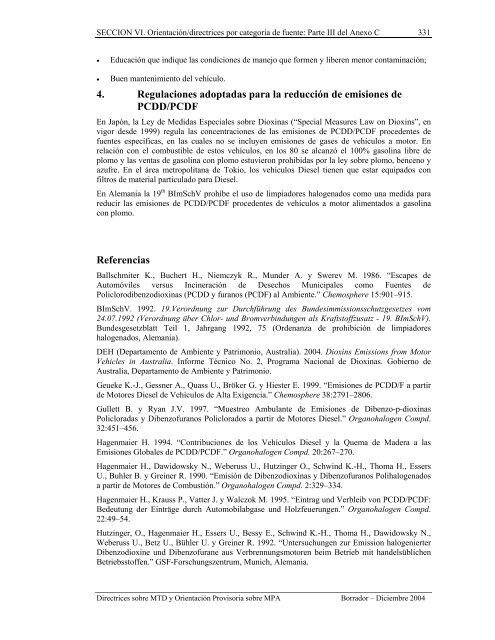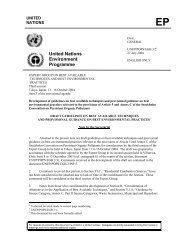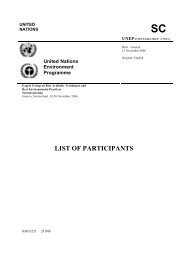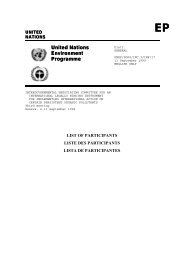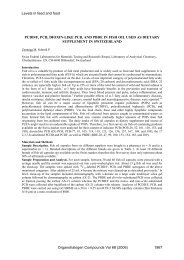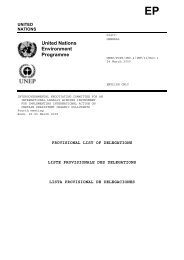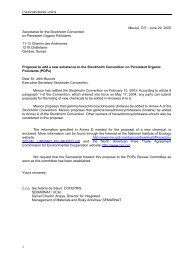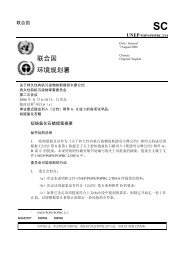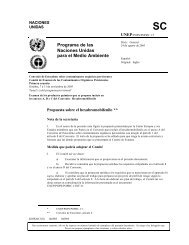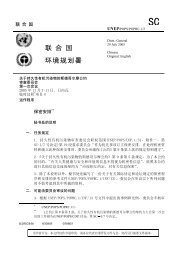Programa de las Naciones Unidas para el Medio Ambiente
Programa de las Naciones Unidas para el Medio Ambiente
Programa de las Naciones Unidas para el Medio Ambiente
Create successful ePaper yourself
Turn your PDF publications into a flip-book with our unique Google optimized e-Paper software.
SECCION VI. Orientación/directrices por categoría <strong>de</strong> fuente: Parte III <strong>de</strong>l Anexo C 331<br />
<br />
Educación que indique <strong>las</strong> condiciones <strong>de</strong> manejo que formen y liberen menor contaminación;<br />
<br />
Buen mantenimiento <strong>de</strong>l vehículo.<br />
4. Regulaciones adoptadas <strong>para</strong> la reducción <strong>de</strong> emisiones <strong>de</strong><br />
PCDD/PCDF<br />
En Japón, la Ley <strong>de</strong> Medidas Especiales sobre Dioxinas (“Special Measures Law on Dioxins”, en<br />
vigor <strong>de</strong>s<strong>de</strong> 1999) regula <strong>las</strong> concentraciones <strong>de</strong> <strong>las</strong> emisiones <strong>de</strong> PCDD/PCDF proce<strong>de</strong>ntes <strong>de</strong><br />
fuentes específicas, en <strong>las</strong> cuales no se incluyen emisiones <strong>de</strong> gases <strong>de</strong> vehículos a motor. En<br />
r<strong>el</strong>ación con <strong>el</strong> combustible <strong>de</strong> estos vehículos, en los 80 se alcanzó <strong>el</strong> 100% gasolina libre <strong>de</strong><br />
plomo y <strong>las</strong> ventas <strong>de</strong> gasolina con plomo estuvieron prohibidas por la ley sobre plomo, benceno y<br />
azufre. En <strong>el</strong> área metropolitana <strong>de</strong> Tokio, los vehículos Dies<strong>el</strong> tienen que estar equipados con<br />
filtros <strong>de</strong> material particulado <strong>para</strong> Dies<strong>el</strong>.<br />
En Alemania la 19 th BImSchV prohíbe <strong>el</strong> uso <strong>de</strong> limpiadores halogenados como una medida <strong>para</strong><br />
reducir <strong>las</strong> emisiones <strong>de</strong> PCDD/PCDF proce<strong>de</strong>ntes <strong>de</strong> vehículos a motor alimentados a gasolina<br />
con plomo.<br />
Referencias<br />
Ballschmiter K., Buchert H., Niemczyk R., Mun<strong>de</strong>r A. y Swerev M. 1986. “Escapes <strong>de</strong><br />
Automóviles versus Incineración <strong>de</strong> Desechos Municipales como Fuentes <strong>de</strong><br />
Policlorodibenzodioxinas (PCDD y furanos (PCDF) al <strong>Ambiente</strong>.” Chemosphere 15:901–915.<br />
BImSchV. 1992. 19.Verordnung zur Durchführung <strong>de</strong>s Bun<strong>de</strong>simmissionsschutzgesetzes vom<br />
24.07.1992 (Verordnung über Chlor- und Bromverbindungen als Kraftstoffzusatz - 19. BImSchV).<br />
Bun<strong>de</strong>sgesetzblatt Teil 1, Jahrgang 1992, 75 (Or<strong>de</strong>nanza <strong>de</strong> prohibición <strong>de</strong> limpiadores<br />
halogenados, Alemania).<br />
DEH (Departamento <strong>de</strong> <strong>Ambiente</strong> y Patrimonio, Australia). 2004. Dioxins Emissions from Motor<br />
Vehicles in Australia. Informe Técnico No. 2, <strong>Programa</strong> Nacional <strong>de</strong> Dioxinas. Gobierno <strong>de</strong><br />
Australia, Departamento <strong>de</strong> <strong>Ambiente</strong> y Patrimonio.<br />
Geueke K.-J., Gessner A., Quass U., Bröker G. y Hiester E. 1999. “Emisiones <strong>de</strong> PCDD/F a partir<br />
<strong>de</strong> Motores Dies<strong>el</strong> <strong>de</strong> Vehículos <strong>de</strong> Alta Exigencia.” Chemosphere 38:2791–2806.<br />
Gullett B. y Ryan J.V. 1997. “Muestreo Ambulante <strong>de</strong> Emisiones <strong>de</strong> Dibenzo-p-dioxinas<br />
Policloradas y Dibenzofuranos Policlorados a partir <strong>de</strong> Motores Dies<strong>el</strong>.” Organohalogen Compd.<br />
32:451–456.<br />
Hagenmaier H. 1994. “Contribuciones <strong>de</strong> los Vehículos Dies<strong>el</strong> y la Quema <strong>de</strong> Ma<strong>de</strong>ra a <strong>las</strong><br />
Emisiones Globales <strong>de</strong> PCDD/PCDF.” Organohalogen Compd. 20:267–270.<br />
Hagenmaier H., Dawidowsky N., Weberuss U., Hutzinger O., Schwind K.-H., Thoma H., Essers<br />
U., Buhler B. y Greiner R. 1990. “Emisión <strong>de</strong> Dibenzodioxinas y Dibenzofuranos Polihalogenados<br />
a partir <strong>de</strong> Motores <strong>de</strong> Combustión.” Organohalogen Compd. 2:329–334.<br />
Hagenmaier H., Krauss P., Vatter J. y Walczok M. 1995. “Eintrag und Verbleib von PCDD/PCDF:<br />
Be<strong>de</strong>utung <strong>de</strong>r Einträge durch Automobilabgase und Holzfeuerungen.” Organohalogen Compd.<br />
22:49–54.<br />
Hutzinger, O., Hagenmaier H., Essers U., Bessy E., Schwind K.-H., Thoma H., Dawidowsky N.,<br />
Weberuss U., Betz U., Bühler U. y Greiner R. 1992. “Untersuchungen zur Emission halogenierter<br />
Dibenzodioxine und Dibenzofurane aus Verbrennungsmotoren beim Betrieb mit han<strong>de</strong>lsüblichen<br />
Betriebsstoffen.” GSF-Forschungszentrum, Munich, Alemania.<br />
Directrices sobre MTD y Orientación Provisoria sobre MPA Borrador – Diciembre 2004


